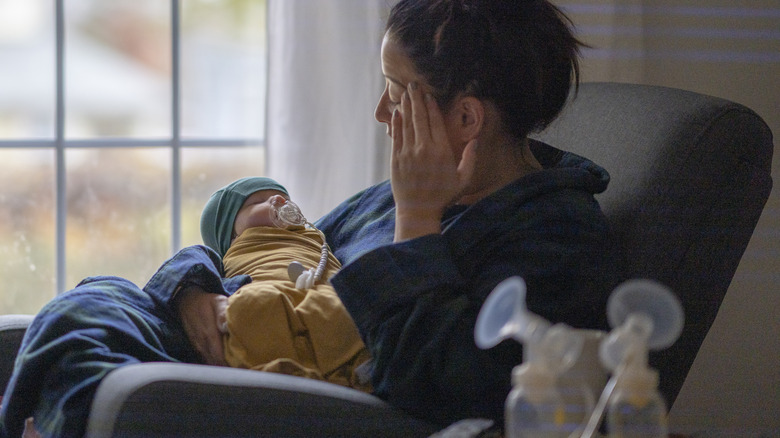Why We Should All Be Paying Attention To The Maternal Mortality Rate In The US
The U.S. has the highest maternal death rate of any developed nation in the entire world, with 1,205 birthing people dying in the nation in 2021 due to maternal causes. The World Health Organization defines maternal deaths as deaths related to or in some way agitated by pregnancy or pregnancy management. These deaths can occur during pregnancy, childbirth, or up to 42 days after the termination of a pregnancy. What is especially concerning is the recent spike in the U.S. maternal mortality rate, which doubled from 2018 to 2021.
The U.S. also ranks last in a study of 41 nations when it comes to paid parental leave, as the only nation in the group that does not mandate paid leave for new parents. This not only further contributes to the pressure placed on new parents to return to work, but recent data also suggests that this lack of parental leave is directly contributing to increasing mental health concerns for expecting and new parents, with some experiencing devastating medical consequences. The maternal mortality rate in the U.S. is a healthcare crisis that must be addressed before more people die unnecessarily.
What's behind the high mortality rate?
A significant contributing factor to the U.S.'s high maternal mortality rate is the lack of access to medical care. Researchers with the Commonwealth Fund noted that reproductive-aged birthing people in the U.S. were more likely to struggle to pay their medical bills or to even delay and skip necessary care due to the cost. This can lead to skipping necessary appointments, avoiding screening tests that might detect problems early on, and not filling prescriptions for important medications. These researchers noted that 10 million people identifying as women in the U.S. lack health insurance altogether, but that even those with insurance still face cost-prohibitive copayments and deductibles making it difficult for many to actually use it. This financial stress can also further erode one's mental health.
The Commonwealth Fund researchers also discussed medical reasons behind the high mortality rate, including the country's high rate of cesarean sections. They noted that U.S. birthing people face a higher rate of chronic medical conditions (such as high blood pressure, heart conditions, obesity, diabetes, etc.) with one in five reporting two (or more) chronic conditions compared to less than one in 10 in other high-income countries like Germany and France. This means that people in the U.S. are already at a higher risk for complications and death before they're even pregnant. By not receiving adequate care for these chronic conditions due to prohibitive costs and lack of medical access, their medical care once they do become pregnant becomes even more complicated.
Mental health factors
Data suggests that mental health conditions can be another key factor in maternal mortality, with a CDC study from 2019 listing mental health conditions as the overall leading cause of pregnancy-related deaths. 2020 data on maternal mortality included that 9% of maternal mortality one year postpartum was the result of suicide, indicating the dangerous nature that is the lack of paid family leave in the U.S. Affecting half a million birthing people each year, perinatal depression can occur during pregnancy, postpartum, or both. Roughly 10 to 20% of birthers experience perinatal depression, but those numbers double for birthing people of color and those coming from low-income backgrounds.
An article from the American Hospital Association explained that maternal mental health complications (anxiety, perinatal and postpartum depression, birth-related PTSD) affect one in five birthing people, making them the most common complications surrounding childbirth. It also states that 75% of those affected by mental health conditions go untreated, and emphasized that women and birthing people of color are not only more likely to experience these mental health conditions, but they're also the least likely to get help. While the cause of this depression is deeply complicated — genetics, environment, substance abuse, and lack of support can all contribute — the stigma attached to mental health care can make it difficult for many to seek help. Pregnant and postpartum people face incredible pressure to be good parents which can further contribute to not seeking care. This, combined with a willingness to dismiss pregnant people as simply experiencing 'baby blues' has led to a widespread failure to properly screen pregnant people and is actively contributing to preventable deaths.
Groups that are disproportionally affected
The maternal mortality rate for Black cisgender women in 2021 was 2.6 times higher than their white counterparts, while American Indian and Alaska Native (AIAN) cis women were two times higher. March of Dimes elaborated that being a person of color is not the actual cause of pregnancy-related death, but that people of color are disproportionately affected by racism which has serious implications on a person's overall health and well-being. These negative implications put people of color at a higher risk for complications, including death. From lower standards of healthcare to racial prejudice among doctors, female-identifying people of color face a healthcare system that oftentimes refuses to listen to their concerns.
Compared to their white counterparts, birthing people of color face higher levels of preterm births, low birthweights, and births that experienced late or no prenatal care, according to the Kaiser Family Foundation (KFF). While medical causes and healthcare coverage are definitely contributing factors, KFF asserts that social and economic factors (specifically systemic racism and discrimination) are the primary causes of maternal and infant death. Perhaps the greatest example of this is that racial disparities in health outcomes remain even when education and income are factored into the debate, further proving that discrimination is truly at play when it comes to people of color dying.
What we can do about it
How can we stop the spiking rate of maternal mortality? Voting for legislators that prioritize reproductive health initiatives is key. Additionally, staying up-to-date on in-progress legislation that could help the cause is extremely important. The Black Maternal Health Momnibus package was reintroduced to Congress in May 2023 and features thirteen bills addressing different elements of the maternity crisis affecting Black birthing people. You can track the progress of the bills in this package through The Century Foundation, and can also contact your congressional representative to voice your support.
Beyond this, pushing for legislation that guarantees paid parental leave, expands perinatal and postpartum depression screenings, and expands low-cost medical care for pregnant people would have massive effects on our maternal mortality rate and overall health outcomes. The Organisation for Economic Cooperation and Development, or OECD, found that the U.S. spent twice as much on healthcare than the average country they track, and yet has the lowest expectancy. They also noted that the U.S. health system seemed designed to discourage people from actually using it.
You can also donate, volunteer, attend events, and share data from foundations and nonprofits working on the front lines of maternal mortality in the U.S. and across the world. Every Mother Counts, the National Partnership for Women & Families, and March of Dimes all work to end the maternal health crisis. You can also visit resource guides from initiatives like the Maternal Health Learning & Innovation Center, and find data from UNICEF to better educate yourself and find resources for others.




